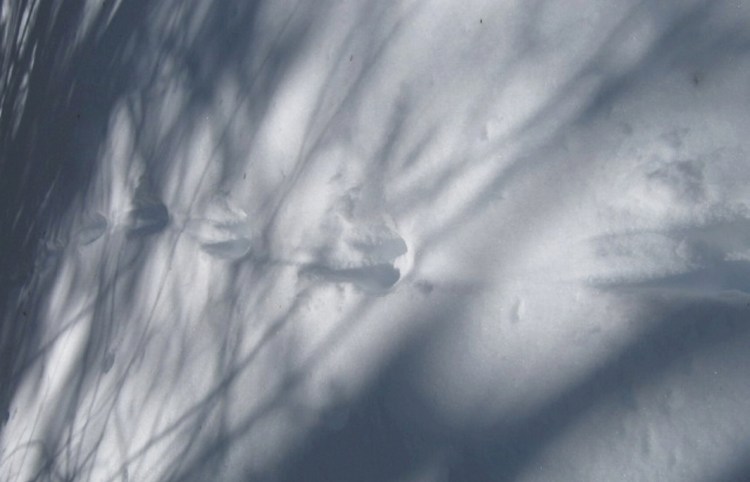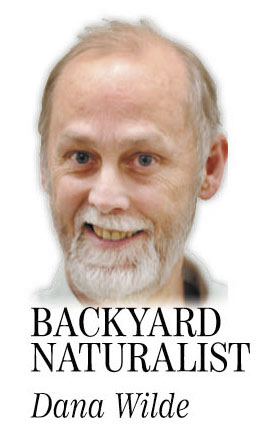The backyard naturalists of the world are by and large hopeless romantics. We’re constantly getting the sometimes reassuring, sometimes disturbing feeling that something big is going on beyond the pulp and chemistry of a fir tree, or a snowflake, or a meadowsweet blossom.
The signs are practically everywhere. They pop into your mind’s eye for a moment, like light glinting on wavetops, as sudden recognitions of similarities between dissimilar things. Some are so obvious they constantly escape your notice until you wake up for a moment or two. Spring is like the beginning of life, a baby. Summer is like the fullness of life, an adult. And winter is like death, the bare trees. Only to turn again to spring, it has been observed, again and again.
Every snowflake crystal is different — within a range of patterns of facets, arms and branches, each one grows perfectly uniquely, just like plants and animals. No two snowflakes, or spruces, or sets of eyes or voices ever match exactly. They crystallize as individuals, float along, then join a great bank of snowflake humanity, where they attach awhile together, then melt away. Next year, new generations of snowflakes form.
Juncos look like leaves hopping along the ground. Some bugs exactly resemble twigs. Glints on midnight snow are starlight bouncing off the Earth. Meadowsweet corollas are little suns. Affection is like the force of gravity, desire like fire, hate like ice. Stars are born, grow up and burn out like living beings. The whole universe is reflecting itself.
On the other hand, thinking so could just be a form of dementia. This would be the prudent diagnosis. We could no doubt wipe it out with a mind-altering drug and get back to reality. But most backyard naturalists don’t want to, because we have the sneaking suspicion that whatever we’re detecting in the silence is as real as photosynthesis.
And in thinking so, we reflect the thoughts of our masters. Henry David Thoreau and the other romantic writers of 150 years or so ago changed the world. They, especially Thoreau, crystallized for us the idea that the natural world is not just a raw material, but a glimpse of forces larger than us. “Let us not underrate the value of a fact,” Thoreau revealed in his essay the “Natural History of Massachusetts”; “it will one day flower in a truth.”
What truth he was talking about is hard to get in focus. But we could never shed the idea, because it’s bouncing off the firs themselves. Despite the best efforts of a certain kind of science to silence them, Thoreau’s resonances are still detected, like invisible beacons from outer space signaling there’s a cohering force or energy that rolls through all things. Annie Dillard’s book “Pilgrim at Tinker Creek,” which she conceived on a camping trip in the wilds of Mount Desert Island around 1970, turns up glimpses of that energy in every nook and cranny of the natural world, like a gasoline fire of snowglints. The green cover slips and we get a little flash of the mirror underneath. Later she wrote an even crazier book called “Teaching a Stone to Talk,” which seemed still further out and closer to the mark. The natural world is saying nothing, and meaning it.
The sense that things here are signs is older than the hills. One morning during the glacial spell that froze us nearly solid, I stopped in the driveway to hear my firs and maples creak and groan.
It meant nothing. I listened intently.
Dana Wilde lives in Troy. You can contact him at naturalist1@dwildepress.net. His recent book is “Summer to Fall: Notes and Numina from the Maine Woods” available from North Country Press. Backyard Naturalist appears the second and fourth Thursdays each month.
Copy the Story LinkSend questions/comments to the editors.




Success. Please wait for the page to reload. If the page does not reload within 5 seconds, please refresh the page.
Enter your email and password to access comments.
Hi, to comment on stories you must . This profile is in addition to your subscription and website login.
Already have a commenting profile? .
Invalid username/password.
Please check your email to confirm and complete your registration.
Only subscribers are eligible to post comments. Please subscribe or login first for digital access. Here’s why.
Use the form below to reset your password. When you've submitted your account email, we will send an email with a reset code.